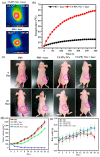Contemporary Polymer-Based Nanoparticle Systems for Photothermal Therapy
- PMID: 30961282
- PMCID: PMC6401975
- DOI: 10.3390/polym10121357
Contemporary Polymer-Based Nanoparticle Systems for Photothermal Therapy
Abstract
Current approaches for the treatment of cancer, such as chemotherapy, radiotherapy, immunotherapy, and surgery, are limited by various factors, such as inadvertent necrosis of healthy cells, immunological destruction, or secondary cancer development. Hyperthermic therapy is a promising strategy intended to mitigate many of the shortcomings associated with traditional therapeutic approaches. However, to utilize this approach effectively, it must be targeted to specific tumor sites to prevent adverse side effects. In this regard, photothermal therapy, using intravenously-administered nanoparticle materials capable of eliciting hyperthermic effects in combination with the precise application of light in the near-infrared spectrum, has shown promise. Many different materials have been proposed, including various inorganic materials such as Au, Ag, and Germanium, and C-based materials. Unfortunately, these materials are limited by concerns about accumulation and potential cytotoxicity. Polymer-based nanoparticle systems have been investigated to overcome limitations associated with traditional inorganic nanoparticle systems. Some of the materials that have been investigated for this purpose include polypyrrole, poly-(3,4-ethylenedioxythiophene):poly(4-styrenesulfonate) (PEDOT:PSS), polydopamine, and polyaniline. The purpose of this review is to summarize these contemporary polymer-based nanoparticle technologies to acquire an understanding of their current applications and explore the potential for future improvements.
Keywords: photothermal therapy; polyaniline; polydopamine; polymeric nanoparticle; polypyrrole.
Conflict of interest statement
The authors declare no conflict of interest.
Figures



References
-
- Heron M.P. Deaths: Leading Causes for 2016. Volume 67 Centers for Disease Control and Prevention; Atlanta, GA, USA: 2018. - PubMed
-
- Nolsoe C.P., Torp-Pedersen S., Burcharth F., Horn T., Pedersen S., Christensen N.E., Olldag E.S., Andersen P.H., Karstrup S., Lorentzen T., et al. Interstitial hyperthermia of colorectal liver metastases with a US-guided Nd-YAG laser with a diffuser tip: A pilot clinical study. Radiology. 1993;187:333–337. doi: 10.1148/radiology.187.2.8475269. - DOI - PubMed
Publication types
Grants and funding
LinkOut - more resources
Full Text Sources

